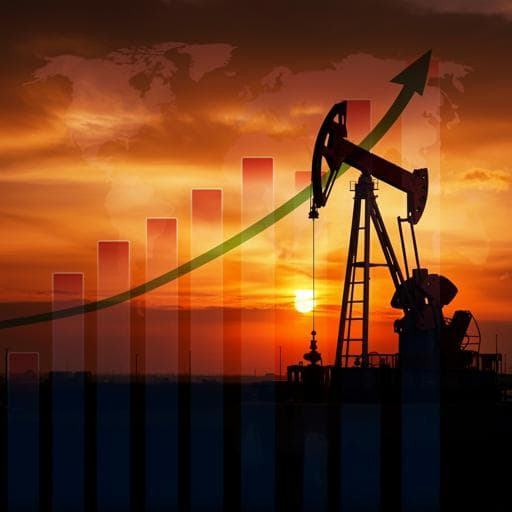
Economics
The impact of Russia-Ukraine war on crude oil prices: an EMC framework
Q. Zhang, Y. Hu, et al.
This intriguing study by Qi Zhang, Yi Hu, Jianbin Jiao, and Shouyang Wang explores the profound impact of the Russia-Ukraine war on crude oil prices. Using a unique Event analysis method, the researchers reveal a dramatic surge in oil prices and significant changes in long-term trends, emphasizing the need for strategic responses to manage energy risks.
~3 min • Beginner • English
Introduction
The Russia–Ukraine war, which began on February 24, 2022, has exerted substantial shocks on the global economy, particularly the energy market. Russia accounts for roughly 12% of global oil production, making the conflict and ensuing sanctions pivotal drivers of oil price dynamics. Following the outbreak, Brent and WTI futures briefly reached their highest levels since 2008 before experiencing persistent volatility shaped by negotiations, sanctions, and monetary policy shifts (notably U.S. Federal Reserve rate hikes and dollar appreciation). This study addresses three questions: (1) How much did the war cause crude oil prices to rise? (2) Are impacts similar across the American (WTI) and European (Brent) markets? (3) How can one identify and separate other concurrent effects within the event window (e.g., U.S. dollar strength, COVID-19 variants)? Traditional event study methods risk bias by not isolating overlapping factors. The authors propose an EMC framework combining VMD and multiresolution causality testing to separate the war’s net effect from other contemporaneous influences and to assess whether the war altered the long-term trend of crude oil prices.
Literature Review
Prior research shows extreme events—wars, pandemics, recessions—significantly affect energy markets. Studies using geopolitical risk (GPR) indices find geopolitical risks are key determinants of crude oil price levels, returns, and volatility; incorporating GPR improves oil price forecasts. The effects of extreme events vary: supply crises (e.g., Gulf War, 9/11, COVID-19) typically raise short-term volatility; financial crises often have longer-lasting effects. Different event typologies (natural vs. artificial; supply vs. demand shocks) reveal heterogeneous impacts on price levels and volatility, with epidemics standing out among natural disasters. Mechanisms include sentiment and speculation, inventory dynamics, supply disruptions in producer oligopolies (especially Middle East), and demand-side effects via macroeconomic downturns and financial or liquidity demand. Methodologically, event analyses (including EMD-based decompositions) have been applied to wars, financial crises, and commodity markets. However, EMD suffers from modal mixing, noise sensitivity, and boundary effects. VMD offers improved theoretical grounding, robustness, and reduced modal mixing, and VMD-based forecasting often outperforms EMD. A key gap is that many event studies fail to isolate other contemporaneous influences within the event window, leading to biased estimates. The paper’s innovations are: proposing an EMC framework to compute the net effect of extreme events; using multiresolution causality testing to separate mixed events within the window; and employing VMD instead of EMD to improve decomposition reliability.
Methodology
The authors develop an EMC (Event analysis based on Multiresolution Causality testing) framework to quantify the net impact of the Russia–Ukraine war on crude oil prices while isolating overlapping influences. Steps: (1) Determine the event of interest (the Russia–Ukraine war) and identify other factors potentially affecting oil prices concurrently (e.g., GPR, U.S. dollar strength). (2) Select data frequency and windows: use high-frequency data and sufficiently long analysis window to capture short-term extreme event effects. Define an estimation window (pre-event) and an event window (during the event). (3) Apply Variational Mode Decomposition (VMD) to decompose crude oil price series and related variables into intrinsic mode functions (IMFs) at different center frequencies; VMD avoids EMD’s endpoint effects and modal mixing by solving a constrained variational problem and extracting band-limited AM–FM components. (4) Perform multiresolution causality testing: conduct Granger-type causality tests on original series and on each IMF scale between GPR and crude oil prices, and between the U.S. dollar index and crude oil prices, to determine which factors causally drive oil price fluctuations at various scales. Factors with significant causality must be accounted for or peeled off; insignificant ones can be ignored in the event analysis. (5) Identify the main mode(s): use IMF average period (cycle), correlation coefficient with the original series, and variance contribution, alongside statistical tests and reconstruction, to select the principal IMF(s) representing the event-driven component. (6) Breakpoint testing: apply structural break tests (Bai–Perron) to assess whether the event changed the long-term trend of oil prices. (7) Economic interpretation: synthesize short-, medium-, and long-term effects with economic reasoning. Data and implementation: The analysis window spans 2021-06-24 to 2022-10-27 (350 daily observations). The event window is 2022-02-24 to 2022-10-27 and the estimation window is 2021-06-24 to 2022-02-23. Robustness checks use alternative event windows (2022-02-24 to 2022-09-22; 2022-02-24 to 2022-12-01) with corresponding estimation windows. Daily spot prices for WTI and Brent are used. The Caldara–Iacoviello GPR index proxies geopolitical risk; a nominal broad U.S. dollar index captures dollar strength. Each series is VMD-decomposed into 4 IMFs: IMF1–IMF2 (high-frequency), IMF3 (medium-frequency), IMF4 (low-frequency). Multiresolution causality testing (MRA-based, with scale-specific VAR and F-tests) evaluates one-way causality from GPR and from the dollar index to oil prices at each IMF. IMF statistics (mean period, correlation with original series, variance share) identify IMF4 as the main mode. Event effect magnitude is computed as the difference between local minimum and maximum of the main mode within the event window. Volatility amplification is assessed via Hilbert–Huang transform (instantaneous frequency). Long-term trend changes are tested using Bai–Perron structural break tests on monthly Brent prices (1987-05 to 2022-10) using the strucchange R package.
Key Findings
- Multiresolution causality: Significant one-way causality from GPR to both WTI and Brent across original series and all IMFs. No significant causality from the U.S. dollar index to WTI or Brent at the series level or any IMF scale during the window. - Main mode identification: IMF4 (low-frequency) is the principal mode, with correlation coefficients 0.9301 (WTI) and 0.9277 (Brent) and variance contributions 71.87% (WTI) and 73.09% (Brent). IMF3 correlations ≈0.52–0.54 with ≈10% variance; IMF1–IMF2 have minimal contributions. - Event impact magnitudes (event window within analysis window): The Russia–Ukraine war raised WTI by $37.14 (+52.33%) and Brent by $41.49 (+56.33%), measured via the main mode’s local min–max difference. - Attribution of price changes: IMF4 accounts for 70.72% (WTI) and 73.62% (Brent) of total price changes during the event window, interpreted as the war’s contribution. - High/medium-frequency fluctuations: IMF1 and IMF2 capture short-lived fluctuations (<$5.03), with average cycles of about 1 and 2 weeks; IMF3 captures medium-frequency fluctuations (<$9.76) with ≈2-month cycles; their mean effects over the event window are statistically indistinguishable from zero (except for IMF4). - Volatility amplification: Hilbert–Huang instantaneous frequency shows higher and denser activity in the event window than in the estimation window, indicating the war amplified crude oil price volatility. - Long-term trend shift: Bai–Perron tests identify structural breaks in monthly Brent prices at Feb 2001, Nov 2005, May 2008, Mar 2010, Jan 2012, Mar 2016, and Mar 2022, with the last attributable to the Russia–Ukraine war, evidencing a fundamental change in the long-term oil price trend. - Market heterogeneity: The impact on Brent exceeded that on WTI, consistent with Europe’s higher dependence on Russian oil; the Brent–WTI spread widened, peaking at $12.64/bbl on March 23, 2022.
Discussion
The findings directly address the research questions. First, the war’s net effect on oil prices is quantified using the VMD-derived main mode: WTI rose by $37.14 (52.33%) and Brent by $41.49 (56.33%), with roughly 71–74% of price changes attributable to the war during the event window. Second, impacts differ between markets: Europe’s greater reliance on Russian imports made Brent more sensitive than WTI, reflected in a larger increase and a widened Brent–WTI spread. Third, by combining multiresolution causality testing with VMD, the EMC framework isolates the war’s effect by showing no significant causal contribution from the U.S. dollar index at any scale over the window, while GPR causally drives oil prices. High-frequency effects linked to news and negotiations were transient, whereas low-frequency dynamics captured the sustained war-driven trend. The Bai–Perron break in March 2022 demonstrates that beyond short-term spikes and volatility, the war fundamentally altered the long-run trajectory of crude oil prices. These results underscore the importance for policymakers and firms of accounting for geopolitical shocks in both immediate risk management and longer-term energy strategy.
Conclusion
Using the EMC framework (VMD plus multiresolution causality), the study quantifies the Russia–Ukraine war’s net impact on crude oil prices and documents a structural shift in long-term price dynamics. Key contributions include: (1) proposing and implementing EMC to separate overlapping factors within an event window; (2) demonstrating, via causality tests, that GPR (war) rather than dollar strength drove oil prices during the window; (3) identifying IMF4 as the principal mode and quantifying the war’s contribution to price increases and fluctuations; (4) evidencing heightened short-term volatility and a long-run structural break in March 2022. Policy recommendations: establish an emergency oil market management mechanism; diversify oil and gas import sources; promote steady energy transition with renewables; encourage firms to hedge input cost risks using financial instruments. Future research should refine methods to jointly peel off multiple concurrent factors, more precisely attribute effects across IMFs considering supply–demand balances and substitutes, and deepen assessment of the war’s long-term impacts.
Limitations
The EMC application yields a lower bound for the war’s impact because other contemporaneous forces (e.g., COVID-19 variant waves, Federal Reserve rate hikes and dollar strength) may have exerted downward pressure on prices; despite negligible causality from the dollar index in tests, residual influences could persist. For protracted, multi-phase events (e.g., pandemics), multiple event windows should be delineated and analyzed separately. Further methodological work is needed to jointly remove overlapping factors, attribute impacts to specific IMFs under varying drivers (supply–demand equilibrium, substitutes), and refine long-term impact estimation.
Related Publications
Explore these studies to deepen your understanding of the subject.







